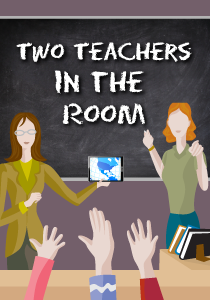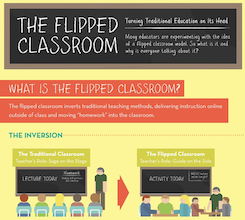Co-Teaching: Looking Back & Planning Forward
A MiddleWeb Blog

We know the feeling of that bittersweet mental tug of war: we are rejuvenated by the idea of summer’s more relaxed pace, while also wishing we had had more time with some or all of our students. We look back on our students’ achievements, and we think about our role in paving the way for them.
Reflection is something we do every day throughout the school year, of course. But it’s in the summer where we actually find the time to reflect more deeply – to listen to that voice inside that informs our teaching behaviors.
It’s a time when we can take what we’ve learned from the year just past and think about how we will apply those lessons to making next year (actually 2 to 3 months from now!) even better.
 The Year at a Glance
The Year at a Glance
Take a few minutes to think about your year as a whole. What action steps did you take to amplify the learning for you and for your students? Jot two of your most important steps on a piece of scrap paper—then come right back. I’ll be here when you’re ready….
My top two action steps:
Let me start things off by sharing my own top action steps.
1: What I did: I introduced Universal Design for Learning (UDL) to my district by presenting a workshop through our Teacher Center and launched a professional learning community (PLC) where I facilitated our study of Loui Lord Nelson’s book Design and Deliver: Planning and Teaching Using Universal Design for Learning. I launched this PLC in February 2014, and we are just getting started, but I’m excited to continue as we move into summer and the new school year.
How it amplified learning: I stepped a little further into my mission of naturally blending UDL into the everyday life of co-teachers—and ultimately student achievement. We’ve much work still ahead—but we’ve taken the first solid steps. It’s so invigorating! I am inspired by my colleagues’ willingness to add their voices. UDL will be the means to ensure that all students in co-taught classrooms have access to the Common Core Standards and Curriculum along with opportunities to close personal achievement gaps.
2. What I did: In my personal learning quest, I needed to extend beyond my immediate materials and resources. Twitter to the rescue! I often fell into my Twitter connections like falling back onto a large cushion for support. I questioned, shared and engaged in learning with such dedicated educators across the globe. I tapped into that Twitter energy and created a chat that is all about co-teaching. What a dream, right?! For 45 minutes, twice monthly, we chat about “everything co-teaching” and how to kick it up to levels of high success! Check out this past post for more details on the first year of the Twitter group #coteachat.
How it amplified learning: The learning and sharing process for me has been truly boundless! My virtual learning helps me to bridge the gap between my thoughts and actions. Little by little, I am sharing my vision in my daily interactions with colleagues in my district. In addition to weaving in UDL as much as possible, I developed a flipped learning science lesson with one of my co-teachers. I’m excited planning more experiences like this during the upcoming school year.
Reflecting on these experiences empowers me to be an active co-teacher who advocates for students—all students—during every breathing moment!
Our most recent twitter Chat
The topic of the most recent #coteachat was about reflection and planning ahead for successful co-teaching partnerships: check out the archive of the chat here. Here’s one of the resources I shared—created by Anne Beninghof. Anne simplifies the shared co-teacher reflection and planning process by structuring it around five key questions:
Q1: How will we introduce ourselves to our students?
I think the response to this one question will set the tone for the remainder of the school year. We must present ourselves in a manner that exemplifies the expertise of both teachers.
Q2: Do you have any pet peeves?
I think the response to this question could snuff out potential co-teaching fires that could spark. Keep communication open and accept one another’s pet peeves.
Co-teachers must make time for the discussions of difficult truths. And these difficult truths must come to the surface early in the school year—to pave the way for a smooth co-teaching and learning pathway.
Q3: When will we plan together?
The wording of this question alone is critical—it states that planning together is a must. Regardless of scheduling glitches—co-planning MUST happen. Enough said. For now.
Q4: What classroom management practices shall we put into place?
Setting the management stage early will create a productive learning environment. And it will limit or even completely diminish the possibility of students playing one teacher against the other (similar to, if mom says no then ask dad).
Q5: How will we share the instructional responsibilities?
The response to this question will get both teachers on a positive course for the year, where both teachers are active co-teachers—simply, smoothly, and naturally.
These questions are a great launching pad as we slide into summer and begin to think about creating successful co-teaching relationships for the upcoming school year. They will without a doubt make it so that positive co-teaching habits are created and maintained throughout the school year.

Anne Beninghof
To find more ideas for planning ahead, visit Anne’s website of co-teaching resources. For some more great reflecting and planning-ahead resources, go to EAA Learning Foundation—shared by one of my #coteachat co-moderators—JM Cataffo. Johnny Cataffo shares such a unique perspective on co-teaching since he has experienced co-teaching from both the general and special education sides.
And one more share before this post is done… Check out this link, which supplies a wealth of resources provided by Dr. Andrea Honigsfeld (who added her expertise to our last #coteachat) and Dr. Maria Dove.
Enjoy your summer – and join us to rev up for fall!
Remember that #coteachat is every 2nd and 4th Tuesday of each month from 8 to 8:45 pm ET. Use the hashtag #coteachat to collaborate with us—it is an inspiring, relaxing, yet invigorating experience—your students will thank you, too! (Find some hashtag how-to here.)
Before signing off, please revisit that quick jot I asked you to write at the beginning of this post. What two action steps did you take to amplify the learning for you and for your students? Please share below – how did they go? What are you thinking about for next year?
I’m looking forward to reflecting and planning with you!

 The Year at a Glance
The Year at a Glance

































Great reflections and insights into the details of co-teaching. You nailed the questions one should be asking if they are endeavoring on this challenge. It is hard work. Relationships are the toughest.